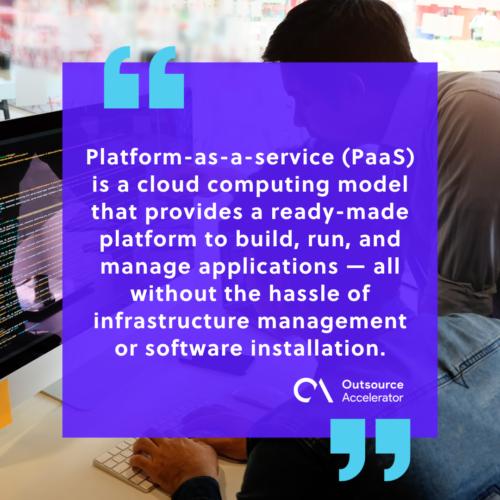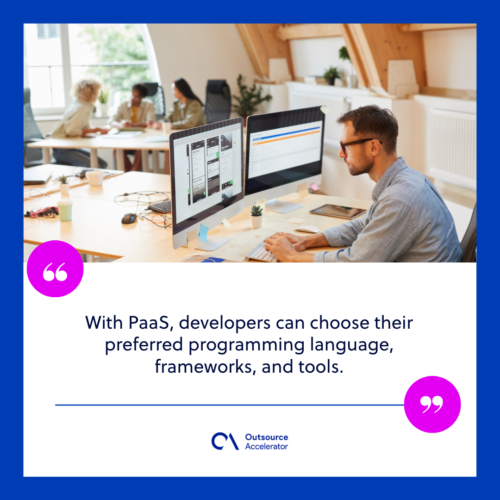What is a Platform-as-a-Service (PaaS)?

If you use a smartphone app, access your emails through a web browser, or utilize cloud-based software, you are likely interacting with a Platform-as-a-Service (PaaS).
PaaS offers developers a virtual toolbox, empowering them to create innovative apps without the burden of manual solutions.
According to Statista, PaaS is one of the primary tiers of cloud computing. It accounts for around 20% of the cloud services market.
This article explores the ins and outs of Platform-as-a-Service. Read on to learn how PaaS works, its benefits, its uses, and how it’s expected to evolve.
Defining Platform-as-a-Service (PaaS)
Platform-as-a-service (PaaS) is a category of cloud computing services that provides a ready-made platform to build, run, and manage applications — all without the hassle of infrastructure management or software installation.
It operates within the cloud infrastructure, eliminating the need for businesses to invest in expensive hardware, software licenses, or IT support. PaaS providers offer a complete development environment that includes development tools, databases, and middleware, which can be accessed over the Internet.
Instead, organizations can focus on creating applications that address their specific business needs and deliver value to their customers.

PaaS vs. SaaS
Though both PaaS and Software as a Service (SaaS) are cloud-based models, they serve different purposes.
SaaS offers ready-made applications accessible through a web browser or mobile app. Meanwhile, PaaS caters to developers by providing them a platform to build their apps.
In simple terms, SaaS is the finished product, while PaaS is the toolbox that developers use to create it.
How does Platform-as-a-Service work?
Platform-as-a-Service abstracts the underlying infrastructure, allowing developers to focus solely on application development.
This abstraction empowers developers to write code, test applications, and deploy them directly onto the PaaS platform.
The provider takes care of all hardware, networking, storage, servers, and operating system requirements.
It then handles the scaling, maintenance, and security aspects. This frees developers from the tedious tasks associated with infrastructure management.
With PaaS, developers can choose their preferred programming language, frameworks, and tools. They can access pre-built components, libraries, and resources to expedite development.
This accelerates the time-to-market for new applications. Therefore, organizations can quickly respond to changing market needs and customer demands.

Benefits of platform-as-a-service
Leveraging Platform-as-a-Service presents many benefits, including:
Streamlined development
PaaS lets developers focus on creating high-quality applications without the distractions of infrastructure management. This boosts productivity, reduces time-to-market, and allows businesses to stay ahead of their competition.
Cost efficiency
Organizations can enjoy cost savings with a Platform-as-a-Service by cutting the need for physical infrastructure and associated maintenance costs.
Businesses can allocate their resources more efficiently, invest in innovation, and avoid expensive upfront investments.
Oracle claims that using PaaS techniques results in up to 50% operational savings
Scalability
PaaS solutions are designed to scale effortlessly. As the number of users and data increases, the platform automatically adjusts resources to meet demand.
This flexibility ensures that applications remain responsive, even during peak usage periods.
Easy collaboration
Platform-as-a-Service facilitates seamless collaboration among development teams, regardless of their geographical location.
Multiple developers can work on the same app simultaneously, which makes sharing code, tracking changes, and ensuring smooth integration convenient.
Uses of Platform-as-a-Service
Platform-as-a-Service (PaaS) solutions can be used across various industries and applications. They offer a comprehensive suite of development tools and services that enable development teams to build, test, and deploy applications rapidly and efficiently.
Here are a few examples:
Custom application development
PaaS allows businesses to create bespoke applications that meet their unique needs. It provides the foundation for building tailored solutions.
It can be used to design a customer relationship management (CRM) system, an e-commerce platform, or an inventory management system.
Mobile application development
Platform-as-a-service solutions offer developers the tools and resources to build robust and user-friendly apps. These applications can be integrated into iOS, Android, and other mobile platforms.
Internet of Things (IoT) solutions
PaaS simplifies the development of IoT solutions by providing ready-made platforms for connecting, managing, and analyzing data from IoT devices.
This enables businesses to harness the power of IoT technology without the complexities associated with infrastructure management.
Future of the Platform-as-a-Service market
The Platform-as-a-Service market is poised for tremendous growth in the coming years.
Allied Market Research projects the global PaaS market to reach $319 billion by 2023, exhibiting a CAGR of 22% from 2021 to 2030.

The increasing adoption of cloud-based technologies, the rise in application development, and the demand for agility and scalability are driving this growth.
As the market evolves, we can expect to see advancements in the following areas within the PaaS sphere:
- Machine learning
- Artificial intelligence
- Serverless computing
These innovations will further empower developers, letting them create intelligent and sophisticated apps that cater to the dynamic needs of businesses and consumers.
Ultimately, Platform-as-a-Service is revolutionizing how applications are built, deployed, and scaled.
As this service continues to expand, we can expect even more integration with emerging technologies, making PaaS a key player in the future of cloud computing.
Whether you’re a tech pro or making business decisions, staying tuned to the changes in Platform-as-a-Service is a wise move for navigating the tech world.







 Independent
Independent




